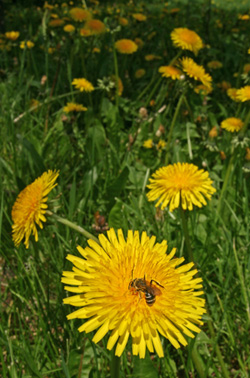
A sure sign of spring is dandelions in bloom. This ubiquitous yellow flower seems to spring up overnight to create a cheerful floral display followed by billowy seed heads floating on long stalks above the ground. The word “dandelion” means “lion’s tooth,” probably a reference to its jagged leaves.
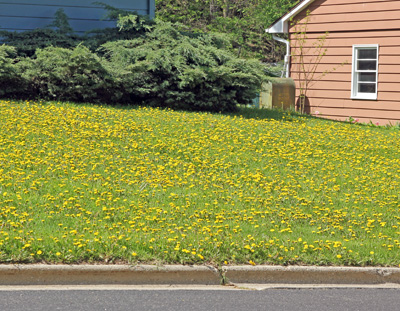
Taxaracum officinale, a common plant of grassland and cultivated ground, is native to Eurasia but has naturalized in all parts of the Northern Hemisphere thru USDA Zone 3. Most people are less than enchanted with dandelions – particularly when they’re more numerous than the grass in a home lawn. But this plant is actually cultivated in some places, and used for both food and herbal remedies. Dandelion is a good colonizer that is excellent at dispersing its prolific seeds.
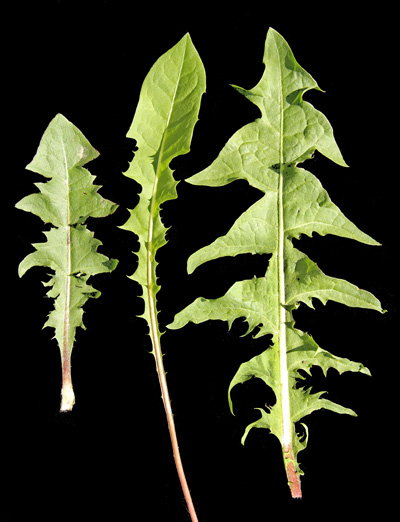
Dandelion is a short-lived perennial that will grow just about anywhere, regardless of soil conditions, but rich soil will improve its growth. They withstand frost and freezes and tolerate crowding. Heat and insufficient moisture will cause the leaves to get bitter, but it won’t kill the plant. The lance shaped leaves grow in a rosette, emerging early in the spring from the crown. Individual leaves may be entire or lobed, with the toothed lobes anywhere from shallowly to deeply incised. Different lobe patterns may occur on the same plant. The rosette of leaves can be a food plant for the caterpillars of some butterfly and moth species.
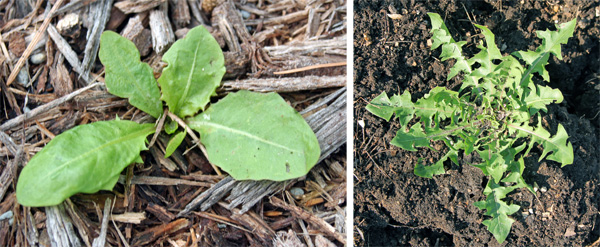
A flush of bright yellow flowers are produced very early in the spring. Even though its flowers are more conspicuous early in the season, it will bloom almost throughout the year. Each solitary inflorescence consists of numerous ray and disc flowers borne together in a daisy-like flower on the end of a smooth, hollow stalk. The stem contains milky latex sap. The length of the flower stalk varies considerably depending on the conditions.
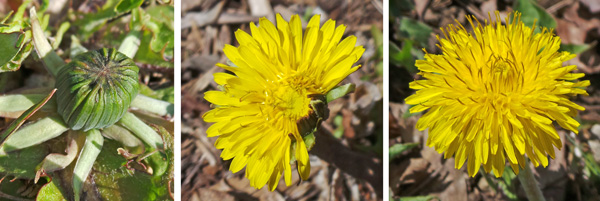
The flowers are utilized by bees and other pollinators and can be an important nectar source early in the season when few other flowers are blooming.
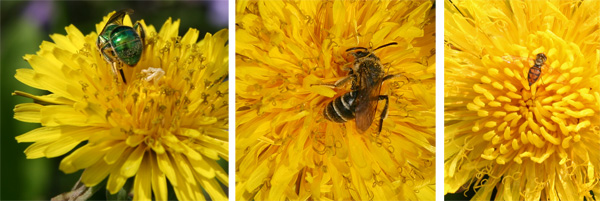
The flowers are followed by the distinctive globe-shaped seed heads. Each seed has a pappus, a feathery parachute of soft, white hairs that makes it easily carried by the wind. Each plant can produce up to 20,000 viable seeds.
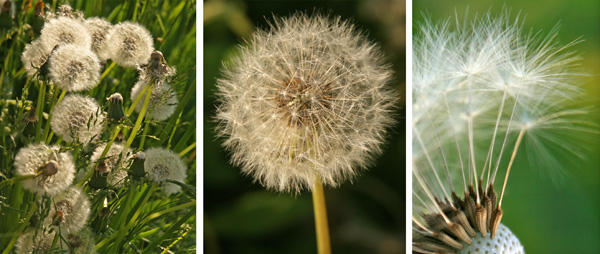
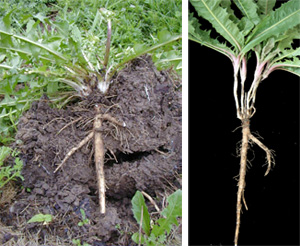
Dandelion can also reproduce vegetatively from pieces of tap-root, with the upper sections of the root having greater viability. The deep tap-root, up to 3 feet long (but usually 6-12”), allows it to survive drought and competition with other weeds.
Depending on your perspective, dandelion is either a weed or wild vegetable that is more nutritious than broccoli and spinach. Though never cultivated as a vegetable in Europe, plants were brought to market in England in the 19th century when lettuce and endive were scarce. Dandelions also appear on the menu in some locations. In Catalonia, pheasant or duck is often prepared with dandelions in the fall (el faisà o l’ànec amb queixals de vella) and in Macedonia Radíkia Me Rízi Tis Kyrías Agápis is a dish of dandelion and chicory cooked with rice and pine nuts.
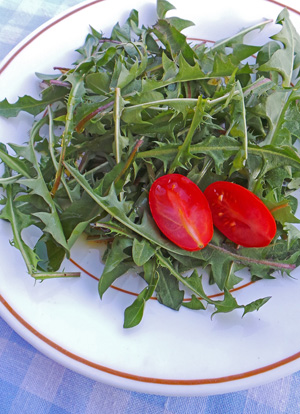
Nearly all parts of this plant can be eaten. Regardless of which part you intend to eat, make sure the dandelions have not been treated with chemicals and wash them thoroughly to remove all soil and insects from the underside of the leaves or roots. The leaves, which are high in calcium, potassium, and iron, are best when they are young and tender, and are most flavorful in early spring before the first flower buds appear.
The roots can be eaten as a vegetable with a turnip-like flavor if dug in early spring. Be cautious of ingesting too many roots as they are reported to be both a diuretic and a laxative.
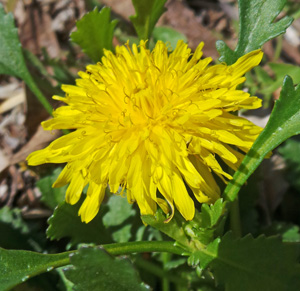
Blossoms, too, can be eaten fresh and are sweetest when picked early in the season. They should be used immediately after picking because the flowers will close up quickly.
Dandelion sap contains latex, so some people may be allergic to dandelions. Anyone allergic to latex should also avoid handling fresh dandelions because of the latex in sap.
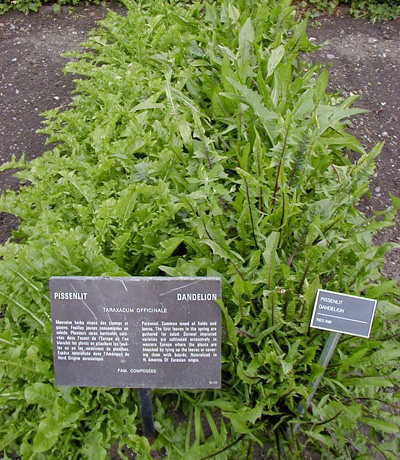
Should you actually want to grow dandelion intentionally, sow the seeds on the soil surface or slightly covered from early spring (4-6 weeks before last frost) through late summer. They should germinate in ten days at 55ºF. Space the plants six to nine inches apart in rows twelve inches apart. You can also get a head start by sowing in early spring in a cold frame or indoors, then transplanting the seedlings into individual pots when they are large enough to handle (but use a pot deep enough to accommodate the tap root), and then plant them out in early summer. It’s essential to pick the flower heads, not only to keep the plant’s energy going to root and leaf production, but also to spare yourself future weeding. Your crop should be ready in 85 to 95 days. Check your local regulations before sowing your crop; in some places (e.g. Pueblo, Colorado) it is illegal to grow dandelions!
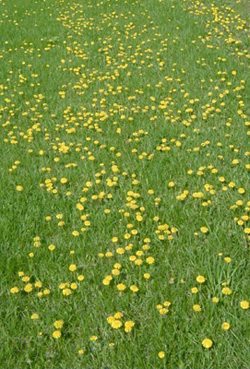
Commercial seed is available but difficult to find in the U.S. It’s probably easiest to just harvest your own seed from plants in your own yard or a neighboring field. (There are supposedly are some named varieties with larger, more tender and less bitter leaves, but they don’t show up in any web searches.)
No matter how many dandelion leaves and flowers you pick to eat early in the season, this probably won’t be sufficient to control their spread in your yard. Dandelions are generally only a problem in lawns that are not growing vigorously enough to out-compete the weeds. The first step in dandelion control is to create a thick, healthy lawn that will prevent dandelions (and other weeds) from getting started in the first place. If you are having a dandelion issue, perhaps the lawn needs more fertilizer or the soil is too compacted or the grass has not been mown at the proper height.

If there are only a few dandelions in an area, mechanical control may be the best option. Use a digging stick or other garden tool that can be inserted into the ground along the dandelion root to pop the dandelion and at least 2-3” of its root out of the ground. Plants will regenerate from root pieces, particularly from the top half of the root, so try to pull as much of the root out of the ground as possible.
Broadleaf weed killers, such as 2,4-D, dicamba, and MCPP, in the common “weed & feed” fertilizer mixtures will kill dandelions whenever the plants are actively growing. Spot treating individual plants that occur sporadically throughout the yard may be more effective than broadcast treatments in well managed lawns.
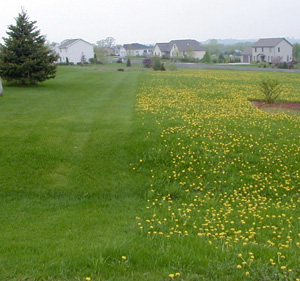
Although late summer and early fall is the best time to control dandelions, spring applications of 2,4-D will have some effect. Dry granular formulations must be applied to wet grass and weeds; the material is only effective if it sticks to the leaves. Liquid formulations can be applied anytime but choose a calm day so the material will not blow or drift onto other plants. Remember that broadleaf weed killers will kill many plants, not just weeds. Dicamba is absorbed through the root system of plants, so keep products containing this herbicide away from shallow-rooted trees and shrubs to prevent injury. Regardless of the product, read the label and mix and apply according to the directions.
Herbicides containing the active ingredient glyphosate are not the best choice for dandelion control. The chemical quickly knocks back the leaves, but doesn’t kill the root. The plant that regenerates often has a group of weak stems coming back from the root, that break off easily, making it even more difficult to dig out.
– Susan Mahr, University of Wisconsin – Madison
Ask Your Gardening Question
If you’re unable to find the information you need, please submit your gardening question here:





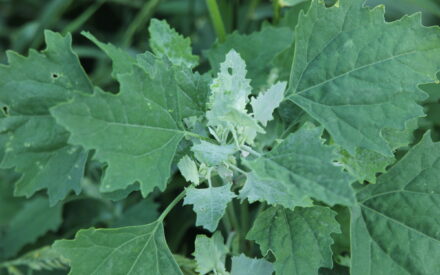 Common Weed Seedlings of the North Central States
Common Weed Seedlings of the North Central States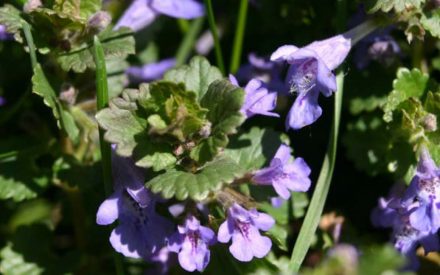 Creeping Charlie
Creeping Charlie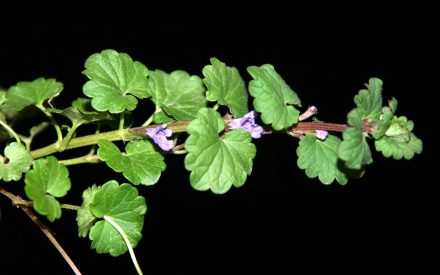 Controlling Creeping Charlie, Gleochoma hederaceae
Controlling Creeping Charlie, Gleochoma hederaceae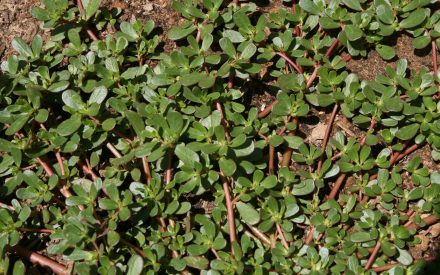 Common Purslane, Portulaca oleracea
Common Purslane, Portulaca oleracea


